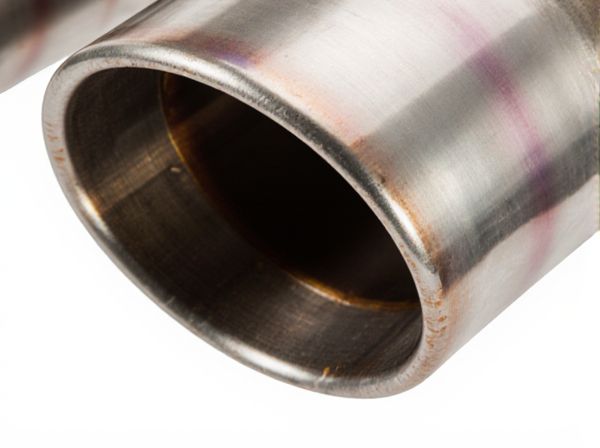
Photo illustration: Slip-fit Joint vs Welded Joint
A slip-fit joint allows components to slide together easily, creating a temporary or adjustable connection often secured with fasteners or adhesives. A welded joint involves melting and fusing materials to form a permanent, strong bond that enhances structural integrity. Choosing between them depends on your need for flexibility or durability in the assembly.
Table of Comparison
| Feature | Slip-fit Joint | Welded Joint |
|---|---|---|
| Installation | Quick, no special tools needed | Requires welding equipment and expertise |
| Seal Quality | Moderate, potential for minor leaks | Strong, airtight seal |
| Durability | Less durable, may loosen over time | Highly durable and long-lasting |
| Flexibility | Allows for easier disassembly and adjustment | Rigid and permanent joint |
| Cost | Lower initial cost | Higher installation cost due to labor |
| Usage | Common in temporary repairs and OEM exhaust systems | Preferred for permanent, high-performance exhaust setups |
Introduction to Slip-fit and Welded Joints
Slip-fit joints provide a mechanical connection by fitting one pipe or tube inside another with minimal clearance, allowing for quick assembly and disassembly without specialized welding equipment. Welded joints create a permanent metal-to-metal bond through processes like arc welding or gas welding, offering superior strength and leak resistance in piping or structural applications. Both joint types are critical in industries such as construction, plumbing, and manufacturing, where the choice depends on factors like load requirements, environmental conditions, and installation speed.
Definition and Design of Slip-fit Joints
Slip-fit joints consist of a slightly loose connection where one component fits over the other without additional fastening, allowing for easy assembly and disassembly. Designed with precise tolerances to ensure minimal gap and controlled clearance, these joints offer flexibility and ease in maintenance compared to welded joints, which involve a permanent fusion of materials creating a rigid and leak-proof bond. Slip-fit joints are ideal for applications requiring quick alignment and adjustment, while welded joints prioritize structural integrity and strength in permanent assemblies.
Definition and Design of Welded Joints
Slip-fit joints involve connecting two components by slipping one part into another, relying on precise tolerances and interference fits for mechanical strength, commonly used in piping and structural applications. Welded joints are created by fusing materials together through heat or pressure, forming a permanent bond that provides superior strength and rigidity, essential in heavy-duty construction and manufacturing. The design of welded joints requires careful consideration of factors such as weld type (e.g., butt, fillet), material compatibility, stress distribution, and appropriate welding techniques to ensure durability and structural integrity.
Key Applications of Slip-fit Joints
Slip-fit joints are primarily used in mechanical assemblies where rapid, reversible connections are essential, such as in piping systems, automotive components, and modular furniture. These joints allow for easy alignment and disassembly without specialized tools, making them ideal for maintenance and adjustments in HVAC ducts, bicycle frames, and scaffolding. Their design supports moderate loads and vibrations while providing a cost-effective alternative to permanent welded joints in applications requiring flexibility.
Key Applications of Welded Joints
Welded joints are extensively used in structural engineering, shipbuilding, and pipeline construction due to their ability to create strong, permanent connections that withstand high stress and pressure. Their applications include automotive manufacturing, aerospace, and heavy machinery, where durability and resistance to dynamic loads are critical. The capability of welding to join complex geometries and dissimilar metals makes it indispensable for fabricating pressure vessels, bridges, and industrial equipment.
Comparative Installation Process
Slip-fit joints offer a simpler installation process by requiring minimal surface preparation and allowing quick alignment of components, which significantly reduces labor time compared to welded joints. Welded joints demand thorough cleaning, precise fitting, and skilled welding techniques to ensure structural integrity and prevent defects such as cracks or corrosion. The slip-fit method is preferable for projects needing rapid assembly, while welded joints are suited for applications requiring higher strength and permanence.
Structural Strength and Durability Comparison
Slip-fit joints offer moderate structural strength, relying on friction and potential adhesives, making them suitable for applications with limited load-bearing requirements. Welded joints provide superior structural strength and durability through a metallurgical bond, ensuring high resistance to stress, fatigue, and environmental factors. In critical structural applications, welded joints are preferred due to their enhanced load capacity and long-term reliability.
Cost Analysis: Slip-fit vs Welded Joints
Slip-fit joints typically incur lower initial costs due to simpler assembly and reduced labor requirements, making them cost-effective for projects with tight budgets or repetitive installations. Welded joints, while more expensive upfront because of skilled labor and specialized equipment, offer superior strength and durability that can reduce long-term maintenance and repair expenses. Evaluating project-specific factors such as load requirements, environmental conditions, and lifecycle costs is essential for determining the most cost-efficient joint method between slip-fit and welded connections.
Maintenance and Inspection Requirements
Slip-fit joints require regular inspections to ensure proper alignment and fit, as loose connections can lead to leaks or structural weaknesses. Maintenance involves routine cleaning and lubrication to prevent corrosion and wear on the joint surfaces. Welded joints, while generally more durable, demand thorough inspection for cracks, corrosion, and weld integrity using non-destructive testing methods such as ultrasonic testing or radiography to ensure long-term reliability.
Choosing the Right Joint for Your Project
Selecting the right joint for your project depends on factors such as material type, load requirements, and environmental conditions. Slip-fit joints offer quick assembly and flexibility, ideal for temporary or adjustable connections, while welded joints provide superior strength and durability for permanent, high-stress applications. Evaluate project demands carefully to balance installation efficiency and structural integrity.
 caratoz.com
caratoz.com